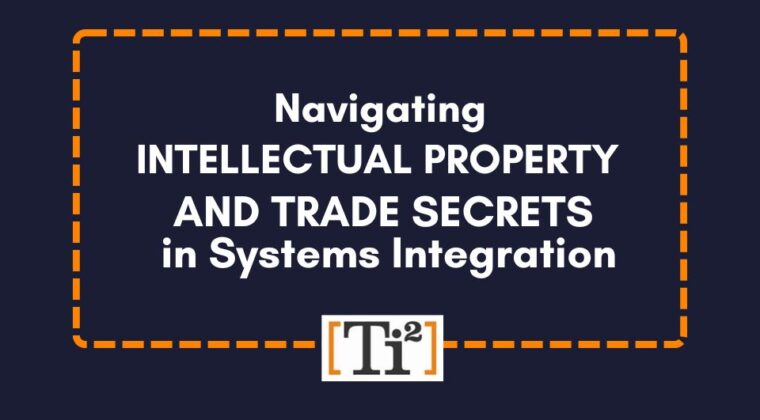In systems integration, the strategic management of intellectual property (IP) and trade secrets is key to innovation and market competitiveness. IP rights protect engineering inventions and designs, allowing for controlled sharing and use. Trade secrets cover critical, confidential technical knowledge, like unique algorithms or system setups, giving companies an edge.
Ti2 utilises these principles in deploying advanced systems integration solutions, leveraging CODESYS for its versatility in automation software. This approach ensures Ti2 delivers bespoke, efficient solutions, emphasising the importance of safeguarding technical innovations in a competitive field. For engineers, understanding IP and trade secrets is essential for creating and protecting valuable, market-leading technologies.
Distinguishing Intellectual Property from Trade Secrets
Intellectual Property (IP) and trade secrets both protect technical innovations but differ mainly in disclosure and duration.
IP, like patents, requires public disclosure and grants exclusive rights for a limited time, typically 20 years for patents. This is crucial for systems integration technologies that can be patented, offering public recognition and investor interest.
Trade secrets offer protection without disclosure, maintaining their value as long as secrecy lasts, potentially indefinitely. This is vital for proprietary techniques or software in systems integration that provide a competitive edge if kept confidential.
The critical distinction often overlooked is the trade-off between IP’s public disclosure (and temporary protection) versus the perpetual but vulnerable protection trade secrets offer if confidentiality is breached. In systems integration, choosing between patenting a technology and keeping it a trade secret can significantly impact competitive strategy and operational secrecy.
The Core of Systems Integration: IP and Technical Innovations
Focusing on the technical core of systems integration, the relevance of IP primarily revolves around the protection of hardware innovations and software algorithms—each crucial for the seamless functioning of integrated systems.
- Hardware Innovations: Patents play a critical role here, protecting unique physical components or the novel application of existing components within systems integration. This includes specialised sensors, actuators, or custom hardware interfaces that allow disparate systems to communicate and operate as a cohesive unit. The patenting of such hardware ensures that the technical solutions developed for systems integration remain exclusive to the inventor, preventing replication by competitors and thereby securing a technological edge in the market.
- Software Algorithms: For software, both patents and copyrights can be applied, though their impact varies. Patents protect specific algorithms or methods that offer a novel solution to a technical problem within the context of systems integration, such as unique data processing techniques or innovative control logic. Copyrights, meanwhile, secure the actual code that implements these algorithms, safeguarding the original expression of these ideas. This dual layer of protection is pivotal in maintaining the integrity and competitive advantage of software-driven solutions in systems integration, ensuring that both the conceptual and expressive aspects of software innovations are legally protected.
Trade Secrets – The Technical Backbone of Competitive Advantage
Trade secrets are essential for maintaining a competitive edge in systems integration, characterised by their secrecy and the economic value they add. To be considered a trade secret, technical knowledge or processes must be confidential, offer a competitive advantage, and be actively protected.
Key trade secrets in systems integration include:
- Proprietary Algorithms: Custom algorithms that optimise system performance or efficiency, offering significant improvements over standard practices.
- System Configurations: Unique configurations of hardware and software that achieve superior reliability, speed, or cost-effectiveness.
- Integration Techniques: Specialised methods for integrating disparate systems or technologies that are not standard in the industry but offer significant advantages in terms of performance or functionality.
Examples include a specialised data encryption method that minimises latency in system communications or a proprietary software tool that significantly reduces integration time and costs. These elements are vital for firms to deliver distinct, high-value solutions. Protection strategies involve strict confidentiality measures to prevent imitation and preserve competitive superiority.
Ti2 and CODESYS
Ti2 leverages intellectual property (IP) and trade secrets within the technical frameworks of systems integration, significantly utilising platforms like CODESYS. IP rights enable Ti2 to protect and share its innovations in automation and integration—such as patented hardware configurations or copyrighted software developed in CODESYS—while keeping them secure from unauthorised replication. In contrast, Ti2’s trade secrets encompass specialised techniques and proprietary algorithms within the CODESYS environment, crucial for their custom solutions but kept confidential to maintain a competitive market advantage.
CODESYS is central to discussions on intellectual property (IP) and trade secrets in systems integration for several key reasons:
- Industry Standard: CODESYS is a leading platform for automation, making it a crucial tool for systems integration and a focal point for IP discussions.
- Customisation Potential: Its adaptability allows for the development of unique solutions, which could be protected as trade secrets.
- Innovation Hub: CODESYS supports the creation of innovative automation solutions, fostering both patentable inventions and confidential trade secrets.
- Market Differentiation: Utilising CODESYS, Ti2 can craft distinct solutions, leveraging IP and trade secrets for competitive advantage.
- Intellectual Asset Protection: The platform’s role in enabling sophisticated solutions underscores the importance of safeguarding developments, whether through patents or as trade secrets.
Ti2 is currently very focused on working with its global partners to secure stock and avoid long delay times in delivering products to their customers. Together with our trusted partners, we are here to provide solutions for your needs. Ti2 continues to work closely with CMZ, Berghof, ODOT, Janz Tec, and more while encouraging the use of CODESYS as a vendor independent platform. Learn more about Ti2 and partners for 2024 HERE.
Contact us HERE if you’re interested in implementing CODESYS in your industrial projects to unlock its benefits and drive innovation in your industry.
Or to learn more about what we can do to help your automation requirements, please click projects, products & services.
Please click here to email us your inquiry, we would like to hear from you.



